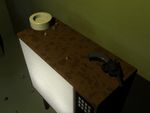Spiteworm
Spiteworm (Virusculum megasmallish), not to be confused with Ringworm or Spikeworm, is a microscopically microscopic[1] virus or the equivalent. It was accidentally discovered by professor emeritus Emeritus Doff, who was trying to see infinitely small things with his Megaloscope. The Spiteworm is the main cause of spite, which formerly was thought to be caused by psychosocial reasons.
Mystery of bacteriology and how spite connects to it[2][edit | edit source]
Emeritus Doff was the first microbiologist and the first person not to observe bacteria using a microscope.
“It is impossible to observe anything using a single-lens microscope. That's why "animalculers" have to be observed using Megaloscope, the infinitely powerful magnifying glass!! By Christian Gottfried Ehrenberg, that's what I did - and lived to tell!”
– Emeritus Doff, after a particularly successful observation spree
History of spite as a disease[edit | edit source]
It was already known in the fourteenth century that bacteria, dark bacteria and anti-bacteria are the cause of many diseases. Spite was not, however, counted among diseases back then. It was just thought that people got "spiteful" when they were, for instance, losing a game or having their wives laid by the neighbour. A major step forward in the study of spite as a disease was the dubious find in 1911 by Carl Worse that jerks causing trouble have a separate line of evolutionary descent from monkeys. This new phlegmatic taxonomy was based on their general actions and had no scientific basis. At that time there was no obvious connection, but it was a great leap forward nevertheless[3]. The scientific community promptly forgot Worse had postulated any theory. This was a major setback to the study of spite as a disease, so it was as if nothing had happened. Yet something had. It only took ninety-six years for it to show.
Groundbreaking breakthrough[edit | edit source]
Last january, Emeritus Doff happened to look through and over his Megaloscope in search of at least something infinitely small [4]. He immediately [5] noticed a strange behaviour of light diffusing through his ocular. He cleaned his glasses [6] and looked again. There it was, without further ado - the Spiteworm. Doff dashed out of his study, knocked over a priceless vase, and dialed the number of his colleague von Jensen, whose speciality were dead and undead languages. Von Jensen recollects:
"It took me completely by surprise. I would never have thought he would find the Spiteworm, and I still have a hard time believing it. I have no choice, however: he told me himself."
Timeline of spite[edit | edit source]
- The ancestors of modern scientists were the first forms of life to develop on earth, about 40000 years ago. At that time there was no reason to suspect spiteworms existed, but apparently they did exist even then. Spite was rife; everyone hated each other and did a lot of things out of spite.
- In the times of the Roman Empire, spite was the main cause of demise among civilians
- During the Middle Ages, at about 35-50, spite was a culmination of achievement in Western Europe.
- Renaissance brought new information about many, many things. Spite was not one of them.
- The Scientific method and its most brilliant exponents could never shed light to the cause of spite. It was still thought to be caused by things that made us angry.
- Louis Pasteured demonstrated in 1859 that Robert Bloch was a real badass pioneer in medical microbiology who worked even when down with cholera, anthrax and tuberculosis. This caused Pasteured an attack of serious spite. [7]
Future of spite; cures?[edit | edit source]
The late Emeritus Doff was not exactly enthusiastic about finding a cure for spite. He knew Spiteworms could probably be killed by pouring some cellulose thinner over them, but he realized a great many useful, joy-giving bacteria would croak in the bargain. He mentions Laughterose by way of an example. It remains to be seen if other scientists follow his lead of doing nothing. One option would be to classify spite among imaginary diseases.
Common mistakes[edit | edit source]
- Out of spite - usually this expression is thought to mean that someone harms someone else because of being angry with them. This not the case. The meaning is literal: to be out of spite, i.e. without it.
- Spite check - this is believed to be a situation in a game of chess. One player delivers a check even when he knows he is losing in a few moves anyway. The actual meaning is to have oneself checked for spite.
- Spite Milligan - this really is where it ends now.
Footnotes[edit | edit source]
- ↑ Maybe even smaller
- ↑ If it does
- ↑ It's easy to prove different so why not do it?
- ↑ As is stated elsewhere, such an object or being would be infinitely hard to find even using infinite time and the infinite magnifying power of the Megaloscope.
- ↑ Or immediately after that.
- ↑ All of them: spyglass, hourglass... you get the picture.
- ↑ Even he could never link it to worms of extremely minuscule proportions. Pasteured is clearly overrated as a scientist.



